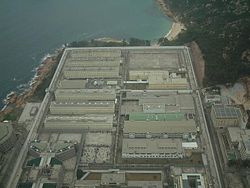Stanley Prison
 | |
 | |
| Location | Stanley, Hong Kong |
|---|---|
| Coordinates | 22°12′43″N 114°13′08″E / 22.21194°N 114.21889°E |
| Capacity | 1,511 |
| Opened | January 1937 |
| Managed by | Hong Kong Correctional Services Department |
| Stanley Prison | |||||||||||||
|---|---|---|---|---|---|---|---|---|---|---|---|---|---|
| Traditional Chinese | 赤柱監獄 | ||||||||||||
| Simplified Chinese | 赤柱监狱 | ||||||||||||
| |||||||||||||
Stanley Prison (c. January 1937, previously known as Hong Kong Prison at Stanley) is one of the six maximum security facilities in Hong Kong.[1]
History
[edit]Built in 1937, Stanley Prison is currently the oldest institution still in service (the oldest prison built in Hong Kong was Victoria Prison, which ceased operation on 24 December 2005[2]) and houses both male adult convicted prisoners and male adult remand prisoners. It was set up by the then Prisons Department, and is now administered by the Correctional Services Department. The maximum capacity of the prison is 1,511 and it has over 800 staff and officers. Stanley Prison, at the time of its construction, was considered to be one of the finest prisons in the British Empire. It was a modern structure built of stone, concrete and steel and consisted of six cell blocks set behind an 18-foot wall. It was originally designed to house 1,500 prisoners.
Before Hong Kong officially abolished the death penalty in 1993, Stanley Prison had been a place of execution between 1946 and 1966. Although the law did not change until 1993, the last execution that was carried out in Stanley Prison was in November 1966.[3] 122 people were executed in Stanley Prison until then, however, this figure does not include the large number of prisoners who were killed by the Japanese during the occupation of Hong Kong in World War II—see below. The area which once housed the gallows has now been replaced with the prison hospital.
Japanese occupation
[edit]Hong Kong fell to the invading Japanese on Christmas Day 1941 following a brief but brutal conflict. During the Japanese occupation, the grounds of the prison were used as part of Stanley Internment Camp. It was a place of torture and execution, with Mateen Ansari, who was posthumously awarded the George Cross for his heroism in resisting the Japanese, as one of the most famous victims. During the Japanese invasion of China, refugees crawled across the border to Hong Kong and many became hawkers on the streets. Those who were caught were sent to Stanley Prison and soon the inmate population grew to over 3,000, well over its limits.
Hong Kong Correctional Services Museum
[edit]Adjacent to Stanley Prison is the Hong Kong Correctional Services Museum.[4] The museum is housed in a two-storey building next to the parade ground of the Staff Training Institute of the Correctional Services Department in Stanley. It has an area of 480 square metres with a collection of some 600 artefacts.
Notable inmates
[edit]- Kanao Inouye: Canadian-Japanese collaborator, hanged in 1947.
- Naomasa Sakonju: Japanese war criminal, hanged in 1948.
- Rurik Jutting: Convicted of the murders of Sumarti Ningsih and Jesse Lorena.
- Chan Man-lok and Leung Wai-lun: Convicted of the Hello Kitty murder case.
- Tony Wong Chun-loong,[5] a.k.a. Wong Yuk-long[6]
- Ting Kai-tai: given a life sentence for the 2008 murder of Wong Ka-mui
See also
[edit]Notes
[edit]- ^ "Maximum Security Institutions". Hong Kong Correctional Services. Archived from the original on 11 March 2005. Retrieved 24 January 2016.
- ^ "A Chronology of CSD's Development and Penal Measures of Hong Kong: 1980's to Now". Hong Kong Correctional Services. 17 April 2007. Retrieved 11 November 2007.
- ^ The last execution in Hong Kong was carried out on 16 November 1966 when Wong Kai-Kei, age 26, was hanged at Stanley Prison. See: "Demise of the Death Penalty", South China Morning Post, 23 March 2004. Official Notebook of Mr R.V Brimmicombie-Wood recording executions in 1966. On display at Hong Kong Correctional Services Museum.
- ^ "Hong Kong Correctional Services Museum". Hong Kong Correctional Services. Archived from the original on 17 February 2006. Retrieved 24 January 2016.
- ^ "Wong to use resources to build new empire". South China Morning Post. 25 April 1993. Retrieved 8 June 2023. - This source says specifically that "Tony Wong Chun-loong", the previous chairperson of Jademan Holdings, went to Stanley Prison.
- ^ Lent, John A. (5 January 2015). Asian Comics. Univ. Press of Mississippi. p. PT131. ISBN 9781626742949 – via Google Books. - It identifies Wong (on the previous page identified as "Tony Wong" and "Wong Yuk-long") as the former head of Jademan and having gone to prison.
